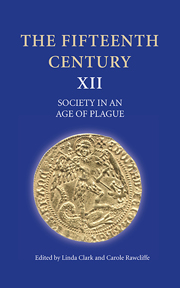Book contents
- Frontmatter
- Contents
- List of Illustrations
- Contributors
- Preface
- Abbreviations
- Introduction
- Looking for Yersinia Pestis: Scientists, Historians and the Black Death
- Pestilence and Poetry: John Lydgate's Danse Macabre
- Pilgrimage in ‘an Age of Plague’: Seeking Canterbury's ‘hooly blisful martir’ in 1420 and 1470
- An Urban Environment: Norwich in the Fifteenth Century
- Mid-Level Officials in Fifteenth-Century Norwich
- Leprosy and Public Health in Late Medieval Rouen
- Plague Ordinances and the Management of Infectious Diseases in Northern French Towns, c.1450–c.1560
- The Renaissance Invention of Quarantine
- Coping with Epidemics in Renaissance Italy: Plague and the Great Pox
- The Historian and the Laboratory: The Black Death Disease
- Index
- CONTENTS OF PREVIOUS VOLUMES
Pestilence and Poetry: John Lydgate's Danse Macabre
Published online by Cambridge University Press: 05 September 2013
- Frontmatter
- Contents
- List of Illustrations
- Contributors
- Preface
- Abbreviations
- Introduction
- Looking for Yersinia Pestis: Scientists, Historians and the Black Death
- Pestilence and Poetry: John Lydgate's Danse Macabre
- Pilgrimage in ‘an Age of Plague’: Seeking Canterbury's ‘hooly blisful martir’ in 1420 and 1470
- An Urban Environment: Norwich in the Fifteenth Century
- Mid-Level Officials in Fifteenth-Century Norwich
- Leprosy and Public Health in Late Medieval Rouen
- Plague Ordinances and the Management of Infectious Diseases in Northern French Towns, c.1450–c.1560
- The Renaissance Invention of Quarantine
- Coping with Epidemics in Renaissance Italy: Plague and the Great Pox
- The Historian and the Laboratory: The Black Death Disease
- Index
- CONTENTS OF PREVIOUS VOLUMES
Summary
O Ye folks hard hearted as a stone,
Whiche to this worlde geue al your aduertence,
Lyke as it should euer lasten in one, –
Where is your wit, where is your prouidence
To seen aforne the sodayn violence
Of cruel death, that be so wyse and sage,
Which slayeth, alas, by stroke or pestilence
Both yong and olde of lowe and high parage?
Death is the active subject in this fifteenth-century poem and is portrayed as a multi-faceted character, being both perceptive and learned but also tactile and aggressive. Plague is the agency, or form of attack, by which Death's desires appear to be fulfilled. His targets: everyone. John Lydgate translated this text, he tells us in the ‘Verba tanslatoris’ or prologue to the poem, from a French original ‘Danse macabre in cimetière des Innocents’, which it is presumed he saw when he was in Paris (as a member of the earl of Warwick's administrative staff) in 1426. A slightly revised version was inscribed and decorated with painted images on the cloister walls of the circular Pardon churchyard at St. Paul's cathedral in London, in about 1430, following a request by John Carpenter, the city's common clerk. It was destroyed about 120 years later during the Edwardian Reformation, in 1549. The text, nevertheless, remains extant in twelve manuscripts. In the majority of these manuscripts the figures with whom Death interacts are: a pope, emperor, cardinal, king, patriarch, constable, archbishop, baron, princess, bishop, squire, abbot, abbess, bailiff, astronomer, burgess, canon secular, merchant, Carthusian, sergeant, monk, usurer, poor man, physician, lover, youthful squire, gentlewoman, man of law, Master John Rykill, fool, parson, juror, minstrel, labourer, friar minor, child, young clerk and hermit. Lydgate makes six additions to his French source: the four women, a juror and a conjuror (Master Rykill).
- Type
- Chapter
- Information
- The Fifteenth Century XIISociety in an Age of Plague, pp. 39 - 56Publisher: Boydell & BrewerPrint publication year: 2013

